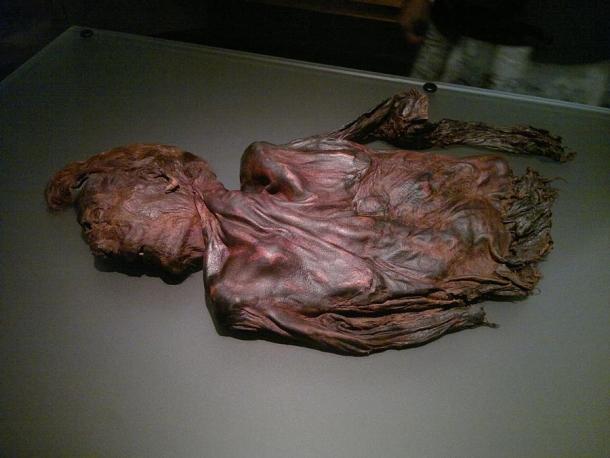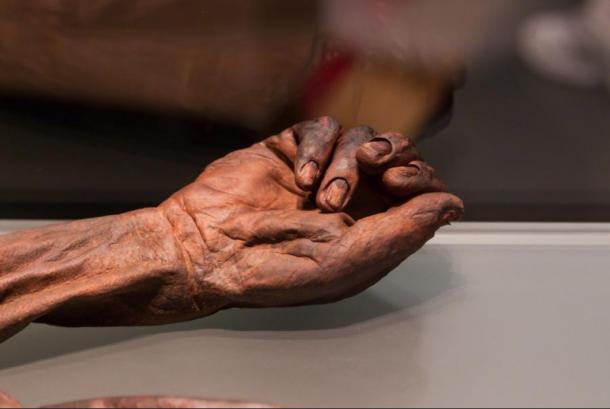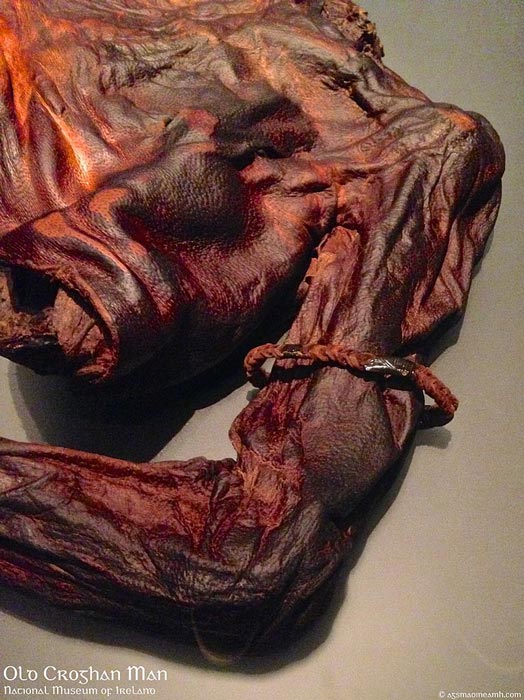Old Croghan Man is the name given to a well-preserved Iron Age bog body that was discovered in County Offaly, Ireland. The bog body derives its name from Croghan Hill, which is situated not far from the site where the body was found. Old Croghan Man was unearthed in 2003, three months after a similar discovery, the Clonycavan Man, was made in County Meath. Analysis of the ancient Croghan Man has provided details about his life and death, and those curious to see him in person can visit the National Museum of Ireland in Dublin.

The Old Croghan Man was found just three months after the discovery of the Clonycavan Man, seen here. (Mark Healey / CC BY-SA 2.0)
Discovering the Old Croghan Man
Old Croghan Man was found in May 2003 when workmen were clearing a drainage ditch through a pit bog. The bog body was discovered near Croghan Hill, north of Daingean, in County Offaly. In February that same year, another bog body known as the Clonycavan Man was found in Clonycavan, County Meath.
Croghan Hill and Clonycavan are separated by about 40 km (25 mi). Clonycavan Man dropped off a peat cutting machine, and it was noticed that his forearms, hands, and lower abdomen were missing. It is thought that these body parts had been hacked off by the machine. Old Croghan Man himself was not complete, as his head and lower limbs were missing at the time of discovery.
After his discovery, various analyses were carried out on the Old Croghan Man, which allowed researchers to extract a range of information regarding the bog body. Part of the Bog Bodies Research Project, which was established in 2003 after these two findings, the project saw 35 specialists working alongside staff from the Irish Antiquities Division and Conservation Department of the National Museum of Ireland to extract information from the bog bodies.
These analyses carried out during the project allowed new interpretations to be made regarding the Celtic Iron Age, the period during which Old Croghan Man lived. According to radiocarbon dating, Old Croghan Man lived sometime between 362 and 175 BC, a period when the Celtic Iron Age was at its height. During this time, the Celts in Ireland were divided into 150 kingdoms, each with its own ruler. It is speculated that Old Croghan Man may have been one of these Iron Age rulers.

The elite status of Old Croghan Man is further supported by his well-manicured hands. (doevos / CC BY-NC-SA 2.0)
Old Croghan Man Was a Member of the Elite
Despite being incomplete, Old Croghan Man was found to be remarkably well-preserved. It was through the analysis of his physical remains that researchers concluded that he was a ruler, or at least a member of the elite. For instance, based on his arm span, scientists estimated that he would have been around 1.98 m (6 ft 6 in) tall. For a man of the Celtic Iron Age, Old Croghan Man would have been exceptionally tall.
The elite status of Old Croghan Man is further supported by his well-manicured hands. This suggests that he did not perform much manual labour whilst he was alive. The braided leather armband found on one of his biceps is thought to represent the sun, which is associated with kingship in Ireland. Additionally, it is noted that the armband is decorated in the “fashionable continental style,” which may indicate links between Ireland and mainland Europe.
Apart from that, chemical analysis performed on his nails found that he had consumed meat regularly for at least four months before his death. In Iron Age Ireland, meat was a luxury enjoyed by the elites of the society. Analysis of the contents of Old Croghan Man’s stomach, however, shows a contrasting picture. It was found that the last meal that he had consisted of cereals and buttermilk. It is speculated that this was a ritual meal.

A braided leather armband was found on one of his biceps. (Ag Smaoineamh / CC BY-SA 4.0)
The Violence Suffered by the Croghan Man Before His Death
Indeed, Old Croghan Man is thought to have been a victim of ritual sacrifice or murder, and likely died an extremely violent death. For a start, it is thought that Old Croghan Man had been decapitated and cut in half, hence the head and lower half of his body being missing when he was discovered. The remaining parts of Old Croghan Man’s body also provide indicators of the violence he suffered before his death.
On Old Croghan Man’s upper arms are holes through which a rope of hazel branches was threaded. This may have been done to restrain him before his murder or sacrifice. A defensive wound on his upper left arm suggests that he might have tried to protect himself during the ordeal. Old Croghan Man was also stabbed in the chest, and struck in the neck.
Moreover, Old Croghan Man’s nipples were sliced off, perhaps the most unusual wound on him. This is used as additional support for the interpretation that he had been a king. According to proponents of this interpretation, in ancient Ireland the king’s nipples symbolised the life-giving sun, and that sucking on a king’s nipples was a sign of submission. Therefore, the act of slicing off a king’s nipples could be regarded as a means to ritually “decommissioning” a king.
Possible Reasons for Killing the Old Croghan Man
Although the various analyses reveal some details about Old Croghan Man’s life, as well as the way he died, they do not provide answers as to why this ancient bog body was murdered or sacrificed. Researchers have, however, speculated on the possible reasons behind his killing. One interpretation, for instance, suggests that Old Croghan Man was a sacrifice to the pagan gods. According to this interpretation, Old Croghan Man might have been a failed king, a failed candidate for kingship, or a political hostage, and therefore ended up sacrificed by another king.
It is speculated that the deity to whom Old Croghan Man was sacrificed was a fertility goddess who had three natures. In addition to governing fertility, this goddess would also have jurisdiction over sovereignty, as well as war and death. This may explain the overkill inflicted on Old Croghan Man.
In order to appease the goddess’ three natures, he had to die three times, by strangulation, stabbing, and drowning. It has been suggested during Old Croghan Man’s time, the climate of Ireland was colder and wetter. This climate could have affected agriculture, and caused food shortage. Consequently, in order to appease the gods, and make the land fertile again, the king had to be sacrificed.
The bodies of Old Croghan Man, and other sacrificial victims like him, are believed to have been placed on the borders of tribal boundaries. Incidentally, In the case of Old Croghan Man, his corpse was placed near the site where the kings of Ui Failge (Offaly) were inaugurated, which happened to be Croghan Hill. It is thought that Old Croghan Man might have been inaugurated as king on the hill some time before his demise. It may even be tempting to imagine that Old Croghan Man himself carried out such sacrifices to ensure a prosperous reign.
Today, Old Croghan Man is displayed in the National Museum of Ireland, in Dublin. Thanks to the research that was carried out on him, as well as on Clonycavan Man, we now have a better idea of kingship in Ireland during the Iron Age. In particular, the bog bodies shed light on the aspect of kings, or failed kings, being ritually sacrificed to ensure the fertility of the land, and the success of another king’s reign.





